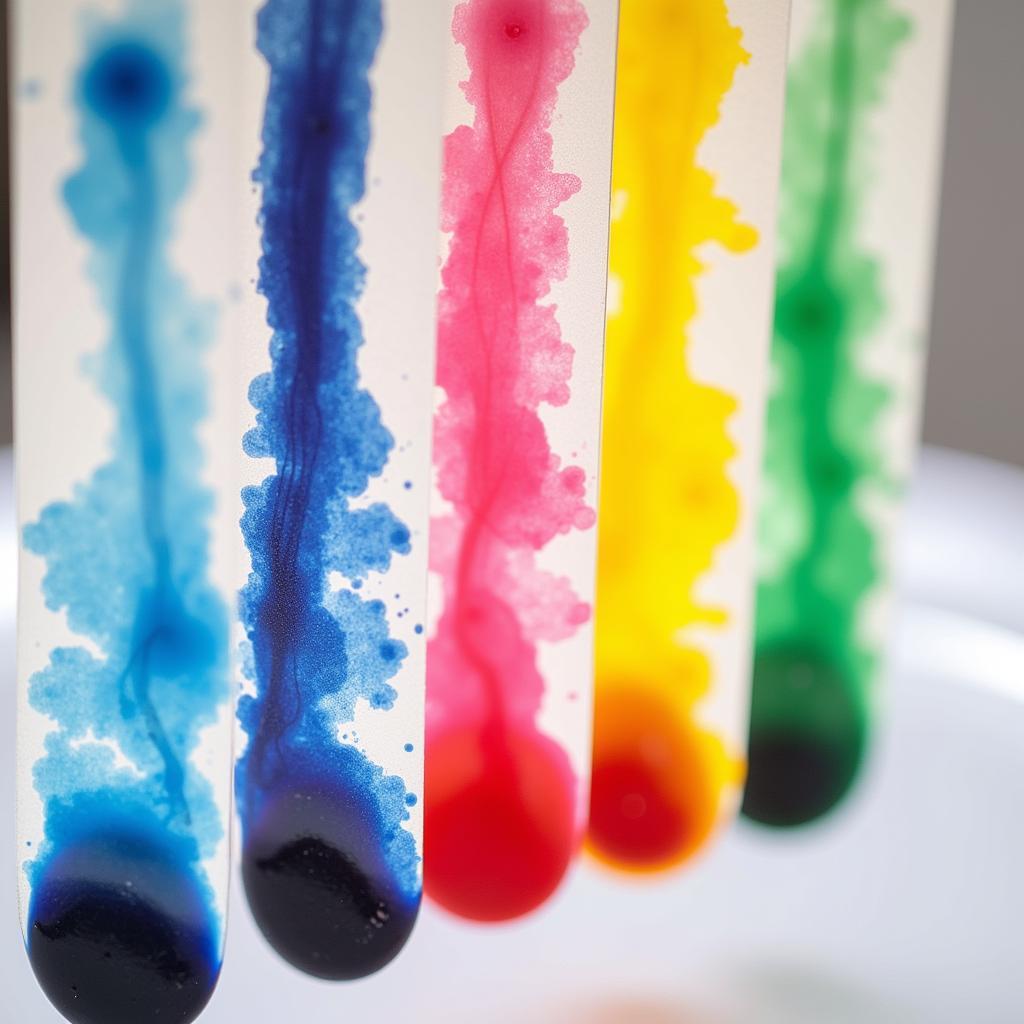Food Dye Chromatography. It might sound like a complicated scientific term, but it’s actually a fascinating process that reveals the hidden beauty and complexity of the colors in our food. Ever wondered how many different dyes create that vibrant green in your favorite candy? Or what gives those colorful cereals their eye-catching hues? Food dye chromatography allows us to separate and identify the individual components of food coloring, giving us a glimpse into the science behind the shades.
Unraveling the Rainbow: What is Food Dye Chromatography?
In simple terms, chromatography is a technique used to separate a mixture into its individual components. Think of it like a race where different runners have different speeds. In food dye chromatography, we use paper and a solvent (usually water or rubbing alcohol) to separate the dyes in food coloring. The paper acts as our racetrack, while the solvent acts as the starting gun. As the solvent travels up the paper, it carries the different dyes with it. But here’s the catch: each dye has a different affinity for the paper and the solvent. Some dyes cling tightly to the paper and move slowly, while others prefer the solvent and race ahead. This difference in speed causes the dyes to separate, creating a stunning visual pattern called a chromatogram.
 Food Dye Chromatography Experiment
Food Dye Chromatography Experiment
Why Explore the World of Food Dye Chromatography?
Besides being a visually appealing experiment, food dye chromatography offers valuable insights into the world of food science and beyond. Here are a few reasons why this technique is more than just a colorful demonstration:
- Quality Control: Food dye chromatography helps manufacturers ensure the consistency and purity of their food colorings. By analyzing the chromatogram, they can detect any impurities or variations in the dye composition.
- Food Safety: This technique plays a crucial role in identifying potentially harmful dyes that might be present in food products.
- Forensic Science: Believe it or not, food dye chromatography has applications in forensic science! It can be used to analyze dye evidence collected from crime scenes, aiding in investigations.
Setting Up Your Own Food Dye Chromatography Experiment
Ready to unleash your inner scientist? Here’s a simple guide to conducting your own food dye chromatography experiment at home:
Materials You’ll Need:
- Filter paper or coffee filters
- Water or rubbing alcohol (70% isopropyl alcohol works best)
- Food coloring (various colors)
- Tall glasses or jars
- Pencils or skewers
- Tape
- Droppers or toothpicks
Step-by-Step Instructions:
- Prepare the Paper: Cut strips of filter paper or coffee filters. Make sure they are long enough to hang over the edge of your glasses or jars.
- Apply the Dye: Using a pencil, lightly mark a line near the bottom of each paper strip. This will be your starting line. Using droppers or toothpicks, carefully place a small dot of food coloring on the starting line of each strip. Use a different color for each strip.
- Set Up the Solvent: Pour a small amount of water or rubbing alcohol into each glass or jar. You only need enough to cover the bottom of the paper strip without submerging the dye dot.
- Hang the Strips: Tape the top of each paper strip to a pencil or skewer. Hang the strips so that the bottom edge just touches the solvent. The dye dot should be above the solvent level.
- Observe and Analyze: Watch as the solvent travels up the paper strip, carrying the dyes along with it. You’ll notice the colors separating into distinct bands.
- Record Your Observations: Once the solvent has traveled a significant distance up the paper, carefully remove the strips and let them dry. Note the colors you observe and the patterns they create.
 Analyzing Food Dye Chromatography Results
Analyzing Food Dye Chromatography Results
FAQs: Unmasking Common Queries About Food Dye Chromatography
1. Why do some dyes travel farther than others on the paper?
The distance a dye travels depends on its chemical structure and its affinity for the paper and the solvent. Dyes that are more attracted to the solvent will travel farther, while dyes that are more attracted to the paper will move slower.
2. Can I use different types of paper for this experiment?
While filter paper is ideal, you can experiment with coffee filters or even paper towels. Keep in mind that the type of paper can affect the results, so it’s best to stick with a consistent type for comparison.
3. What if my dyes don’t separate well?
Several factors can influence separation, including the type of solvent used, the concentration of the dyes, and even the temperature. If your dyes don’t separate well, try adjusting these variables.
4. Can I use natural food coloring for this experiment?
Yes, you can use natural food coloring, but the results might be less vibrant and the separation might not be as distinct as with artificial food coloring.
5. What are some real-world applications of food dye chromatography?
Food dye chromatography has applications in food safety, quality control, and even forensic science. It helps ensure the quality and safety of our food supply by identifying potentially harmful or unapproved dyes.
Need Help with Your Food Dye Explorations?
If you’re eager to dive deeper into the fascinating world of food dye chromatography or have any culinary queries, our dedicated team at Mina Cones Food is here to assist you. Contact us at Phone Number: 02437655121, Email: [email protected], or visit us at 3PGH+8R9, ĐT70A, thôn Trung, Bắc Từ Liêm, Hà Nội, Việt Nam. We’re available 24/7 to satisfy your culinary curiosities!